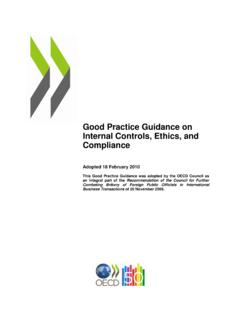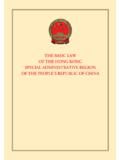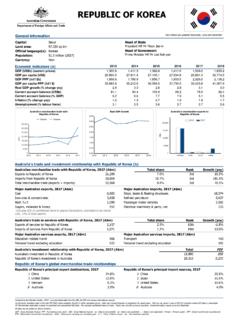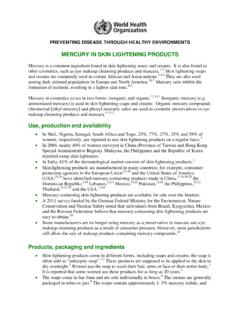Transcription of THE PEOPLE’S REPUBLIC OF CHINA - OECD.org
1 THE people 'S REPUBLIC OF CHINA . AVOIDING THE MIDDLE-INCOME TRAP: POLICIES FOR SUSTAINED AND. INCLUSIVE GROWTH. SEPTEMBER 2013. OCDE Paris 2, rue Andr Pascal, 75775 Paris Cedex 16. Tel.: +33 1 45 24 82 00. Cover page picture - This document and any map included herein are without prejudice to the status of or sovereignty over any territory, to the delimitation of international frontiers and boundaries and to the name of any territory, city or area. **. The statistical data for Israel are supplied by and under the responsibility of the relevant Israeli authorities. The use of such data by the OECD is without prejudice to the status of the Golan Heights, East Jerusalem and Israeli settlements in the West Bank under the terms of international law. T ABLE OF C ONTENTS. Foreword .. 2. Avoiding the middle-income trap: policies for sustained and inclusive growth .. 3. Food security.
2 9. Social safety nets .. 13. Health reform .. 17. Green growth .. 22. Climate Change .. 28. Urbanisation and sustainable development .. 33. 1. FOREWORD. Despite impressive economic performance over the last three decades, CHINA is now at a crossroads, and further reforms are needed to ensure broad, sustainable and equitable growth in the years to come. Sizeable investment in physical and human capital, a dynamic and competitive export sector, and commitment to sound economic management have been key drivers of growth. But, as the Chinese authorities have emphasised, a transition towards a growth model that is more broad-based and reliant on the dynamism of domestic demand is now needed. Ensuring that growth is sustainable and inclusive will enable CHINA to avoid the middle income trap and possibly make its economy the world's largest by 2030. Ambitious reforms in the financial, land and labour markets can do much to bring this Chinese Dream centred on national development, individual prosperity, good governance and sustainable growth to full fruition.
3 In particular, CHINA would do well to strengthen the coverage of its social security system, address growing health challenges, meet the demand for living space through better urbanisation, improve energy efficiency, increase food security, boost innovation and promote policies to curb pollution. Financing some of these efforts would call for reforming the tax system and improving fiscal relations among the different layers of government. The experience of OECD countries that have managed well the transition towards more affluent societies underscores the importance of broad-based reforms. For example, efforts to step up innovation and the dynamism of the services sectors become all the more important as a country loses comparative advantages based on low-cost production and exports. Also, ensuring that future growth is environmentally sustainable calls for better price signals to keep pollution in check and avoid the depletion of natural resources.
4 Drawing on the expertise and experience of OECD and partner countries, this Report presents an update of OECD policy advice in areas that are critical to CHINA 's long-term economic performance and social development. They include food security, social safety nets, health reform, green growth, climate change and urbanisation. The OECD takes pride in its co-operation and policy dialogue with CHINA over the last decades and looks forward to contributing to CHINA 's stronger, cleaner and fairer economic growth. CHINA 's participation in the work of OECD committees and bodies enriches the policy discussions and outcomes. Today, this partnership is more relevant than ever, as CHINA consolidates its role as a powerful engine of growth for the world economy. Angel Gurr a Secretary-General, OECD. 2. AVOIDING THE MIDDLE-INCOME TRAP: POLICIES FOR SUSTAINED AND INCLUSIVE. GROWTH. CHINA 's economic performance has been outstanding since the reforms launched in 1998, to overcome the marked slowing in economic growth in the late 1990s due to bankruptcy of both state-owned enterprises and the banking system.
5 Since then, GDP growth has averaged just under 10% per year. However, in the past five years growth has slackened. While it is difficult to split cyclical and structural factors, it does seem that the underlying growth rate has declined to around 8% per year (Figure ). OECD projections suggest that over the medium-term this slowdown is set to continue, partly because the working age population will soon start to fall. Against this backdrop, concerns have been voiced that the Chinese economy may fail to catch up as rapidly as in the past with the leading world economies, and may get stuck in a so-called middle-income trap. Figure Actual and trend GDP growth % per year 18. 16. 14. 12. 10. 8. 6. 4. 2. 0. 1996 Q2. 1999 Q2. 1992 Q2. 1993 Q2. 1994 Q2. 1995 Q2. 1997 Q2. 1998 Q2. 2000 Q2. 2001 Q2. 2002 Q2. 2003 Q2. 2004 Q2. 2005 Q2. 2006 Q2. 2007 Q2. 2008 Q2. 2009 Q2. 2010 Q2. 2011 Q2.
6 2012 Q2. 2013 Q2. Actual Trend 8% growth Source: OECD estimates. I S THERE A MIDDLE - INCOME TRAP ? In general, growth is bound to slow once a catching-up economy has reaped the lower- hanging fruits of technology imports and urbanisation. The number of economies that have moved from middle to high income status (defined as having GDP per capita of $12 500 at 2011 prices) is limited but almost one quarter of the current OECD membership has nevertheless successfully made that transition, including a number of neighbours of CHINA . The factors that differentiate those countries that have made the transition from the others are mostly linked to the quality of economic policies. CHINA , of course, is a large and diverse country and the pace of development has varied considerably from one province to another. By 2012, three municipalities had already crossed th the high-income level.
7 If the targeted growth rate of the 12 Plan is achieved, as is likely, 260. million people will be living in high-income provinces by 2015. If the same growth rate can be maintained until 2020, then one billion people would be living in high-income areas by that time. 3. W HAT EXPLAINED PAST G ROWTH ? CHINA 's rapid economic growth since 1998 has been the result of the introduction of a major set of reforms that completely changed the incentives facing companies and individuals. To cite just a few of the changes: the change of state-owned enterprises (SOEs) from enterprises run as government departments into corporations and sale of minority holdings to the public;. the establishment of a viable banking system;. the creation of a new legal environment for companies;. the entry into the World Trade Organisation;. the marked reduction of barriers to the movement of individuals.
8 And the development of a housing market. These reforms boosted productivity growth, though not without short-run costs in some cases. However, by 2008 or so, the impetus from these reforms had begun to fade and productivity gains had slowed. This was most noticeable when comparing state-owned and other forms of companies. Following the reforms, the productivity of SOEs grew rapidly . much faster than that of privately-owned companies as the SOEs reduced their inefficiency. But, after a few years, productivity growth in SOEs started to slacken while productivity in the rest of the economy continued to rise rapidly. Keeping up trend growth at close to 8% will require a new round of reform in various areas, as highlighted in the latest two OECD Economic Surveys of CHINA (OECD, 2010, 2013). Nurturing innovation becomes increasingly important as the technologies used in CHINA catch up with global frontiers.
9 Financial, land, labour market and fiscal reforms are needed to improve resource allocation and make growth greener and more inclusive. B OOSTING INNOVATION. There are weaknesses in the current economic structure. In some areas such as processing and assembly, CHINA 's exports embody little value added generated in CHINA (for example, in the case of some emblematic high-tech electronic handheld devices). In the long run, with growing competition from lower-cost economies, CHINA may see its comparative advantage in such activities eroded. Accordingly, other segments of the value chain have to be improved: upstream activities such as R&D, design, manufacturing key parts and components; and downstream activities such as marketing, branding and customer service. This will complement CHINA 's strong manufacturing capabilities, boost productivity and add value. CHINA 's upgrading may differ from that experienced by other Asian economies.
10 With a vast and fast-expanding domestic market, Chinese firms participating in the value chains of foreign multinational enterprises can also apply the knowledge acquired from their global value chain activities to the development of new capabilities in the domestic market. Upgrading will also demand stepping up innovation efforts. Inputs into research and development more than doubled between 2005 and 2012, reaching $164 billion ( of GDP), with businesses accounting for almost three-quarters of total outlays. By 2010, CHINA was second only to the United States and had the world's largest pool of researchers. The number of both patent applications and grants exceeded those in the United States in 2011. Moreover they are a concentrated in high-tech areas such as digital communications. There are some doubts, though, about the quality of the outputs of the innovation system. Across the world, companies tend to register higher-value patents abroad to maximise the value of their intellectual property.















